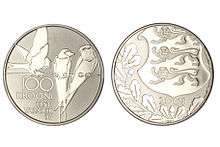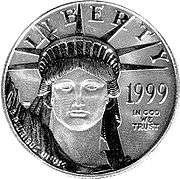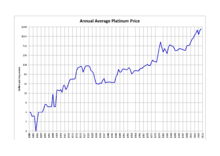Platinum as an investment


Platinum as an investment has a much shorter history in the financial sector than does either gold or silver, which were known to ancient civilizations. Experts posit that platinum is about 15-20 times scarcer than gold, on the basis of annual mine production. Because of this fact, platinum has usually tended to sell at a significant price premium to gold.[1] Since, 2014 platinum rates have fallen significantly lower than gold rates.[2] More than 75% of global platinum is mined in South Africa.[3]
Overview
Platinum is relatively scarce even among the precious metals. New mine production totals approximately only five million troy ounces (150 Mg) a year. In contrast, gold mine production runs approximately 82 million ounces (2,550 Mg) a year, and silver production is approximately 547 million ounces (17,000 Mg).[4] As such, it tends to trade at higher per-unit prices.
Platinum is traded on the New York Mercantile Exchange (NYMEX) and the London Platinum and Palladium Market. To be saleable on most commodity markets, platinum ingots must be assayed and hallmarked in a manner similar to the way gold and silver are.[5][6]
The price of platinum changes along with its supply and demand; during periods of sustained economic stability and growth, the price of platinum tends to be as much as twice the price of gold; whereas, during periods of economic uncertainty,[7] the price of platinum tends to decrease because of reduced demand, falling below the price of gold, partly due to increased gold prices. Platinum price peaked at US$2,252 per troy ounce in March 2008 driven on production concerns (brought about partly due to power delivery problems to South African mines). It subsequently fell to US$774 per troy ounce ($25/g) in November 2008.[8] As of 10 January 2014, the platinum spot price in New York was US$1,428 per ounce, compared to US$1,246.20 per ounce for gold and US$20.18 per ounce for silver. Platinum is traded in the spot market with the code "XPT". When settled in United States Dollars, the code is "XPTUSD".
Investment vehicles
Exchange-traded products


Platinum is traded as an ETF (exchange-traded fund) on the London Stock Exchange under the ticker symbol LSE: PHPT and on the New York Stock Exchange as ticker symbol PPLT[9] There are also several ETNs (exchange-traded note) available,[10] some of which are inverse to the price of platinum. A list can be found at ETFDB, stock encyclopedia.
Platinum coins
Platinum coins are another way to invest in platinum, although relatively few varieties of platinum coins have been minted, due to its cost and difficulty in working. Since 1997, the United States Mint has been selling American Platinum Eagle coins to investors.
Accounts
Most Swiss banks offer platinum accounts where platinum can be instantly bought or sold just like any foreign currency. Unlike physical platinum, the customer does not own the actual metal but rather has a claim against the bank for a certain quantity of metal.
Others
Other ways of investing in platinum include spread betting or contracts for difference on the price of the metal, owning shares in mining companies with substantial platinum assets or exposure, owning traded options in platinum (only available in the US market).[3]
See also
- Alternative investments
- Gold as an investment
- London Platinum and Palladium Market
- Palladium as an investment
- Silver as an investment
References
- ↑ Temple, Peter (12 December 2011). "Platinum anomaly could play for investors". Retrieved 2015-03-25.
- ↑ "Platinum v/s Gold - Historical Price Comparison Chart". Retrieved 2016-11-27.
- 1 2 Louth, Nick (16 December 2011). "How to trade platinum and palladium". iii.co.uk. Retrieved 2015-03-25.
- ↑ "Futures & Options Trading".
- ↑ London/Zurich Good Delivery List
- ↑ "Futures & Options Trading - Brands of platinum". NYMEX.
- ↑ "Platinum versus Gold". The Speculative Invertor.
- ↑ "Spot Price Charts - Silver Spot Prices,Gold Prices,Platinum Prices,Palladium Prices". nwtmint.com.
- ↑ "ETF Securities to sell Platinum, Palladium shares". Commodity Online. April 27, 2010. Retrieved May 10, 2010.
- ↑ "Platinum ETF and ETN list". Platinum ETF. May 15, 2012. Retrieved May 15, 2012.
External links
- Information about Platinum as a commodity from New York Mercantile Exchange
- London Platinum and Palladium Market